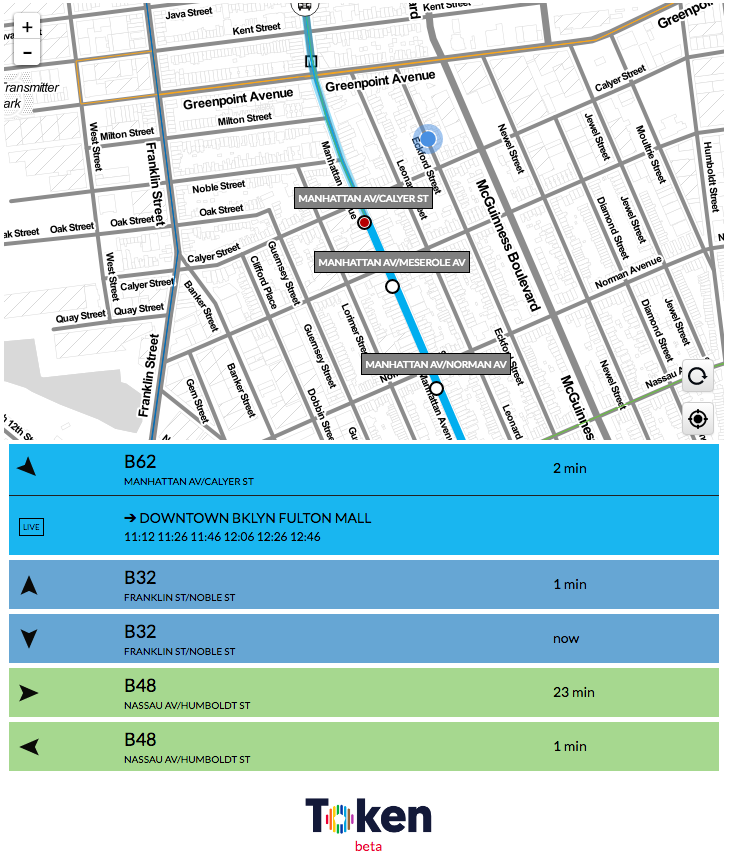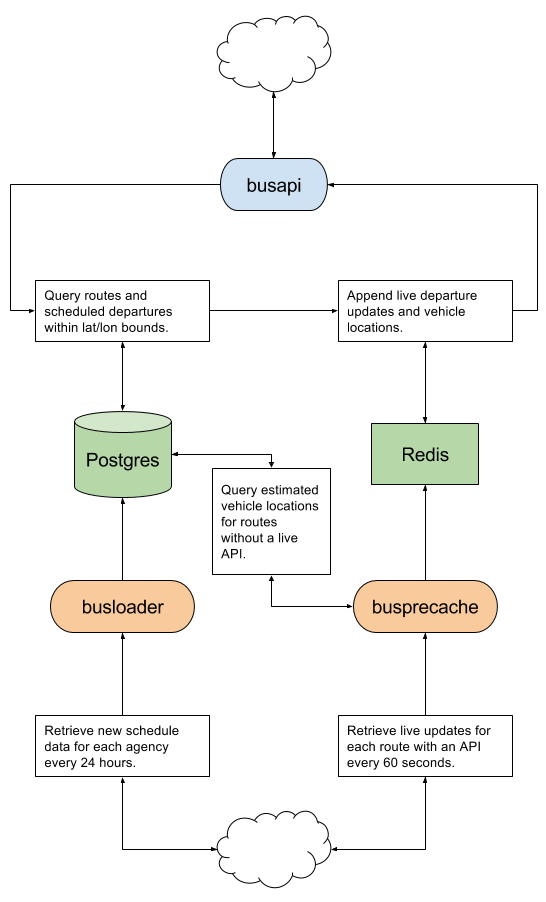Beta version: https://token.live
- Go 1.6+
- PostgreSQL 9.3+ with PostGIS
- Flyway
- Redis
- NPM
- Grunt
- JQuery
- Bootstrap
- Leaflet
- Ubuntu 14 LTS
| Agency | Live departures |
|---|---|
| MTA NYC Transit Bus | All routes |
| MTA NYC Transit Subway | 123, 456, 7, ACE, BDFM, G, JZ, S |
| Staten Island Ferry | Scheduled departures only |
The full system consists of three binaries. Each binary can be configured
using environment variables and typically are run as daemons. They are
located under the cmds/ directory.
busapi is the queryable HTTP API. It also delivers static assets.
busloader downloads static
GTFS files and loads those files
into the db. When it's finished loading a set of files, it updates
materialized views queried by busapi.
busprecache contacts agency-specific live data sources and writes raw
response data to Redis. busapi reads that data to present live
departure and vehicle location data.
busapi and busprecache use these values to config Redis and external
partner sites.
| Name | Description | Default value |
|---|---|---|
BUS_REDIS_ADDR |
host:port of redis |
localhost:6379 |
BUS_REDIS_TTL |
TTL number of seconds for Redis data | 90 |
BUS_AGENCY_IDS |
List of agency IDs we should precache | All supported agencies |
BUS_MTA_BUSTIME_API_KEY |
API key for http://bustime.mta.info/ | None |
BUS_MTA_DATAMINE_API_KEY |
API key for http://datamine.mta.info/ | None |
All three binaries use the following database config. busloader must have
a writeable database, but busprecache and busapi can use a read-only replica.
| Name | Description | Default value |
|---|---|---|
BUS_DB_ADDR |
host:port of postgres |
localhost:5432 |
BUS_DB_USER |
The username to use | postgres |
BUS_DB_PASSWORD |
The password to use | empty |
BUS_DB_NAME |
The database name to use | postgres |
| Name | Description | Default value |
|---|---|---|
BUS_API_ADDR |
The HTTP host:port we listen to | 0.0.0.0:8000 |
BUS_WEB_DIR |
Location of static web assets | ../../web/dist |
BUS_BUILD_TIMESTAMP |
Timestamp to send with static files in query string | Use API startup time |
BUS_LOG_TIMING |
Log timing of certain queries | false |
| Name | Description | Default value |
|---|---|---|
BUS_TMP_DIR |
Path to temporary directory | os.TempDir() |
BUS_GTFS_URLS |
Comma-separated path to GTFS zip URLs | None |
BUS_ROUTE_FILTER |
Comma-separated list of route_id values to filter on (i.e., only load these routes) |
None (no filter) |
BUS_LOAD_FOREVER |
Load forever (24 hour delay between loads) if true, exit after first load if false |
true |
No specific config, just the shared cache and db configs above.
In the automation/ directory, there is a sample of how to fully deploy the
system. A full configuration for a deploy consists of an inventory file and a
group_vars/ file. The included config is called inventory_vagrant. For
security reasons (the API keys), the vars are encrypted in this repo. You can
create your own config and deploy it locally by doing the following:
# Create vagrant server
$ cd automation/vagrant
$ vagrant up
$ cd ../..
# Overwrite group vars with defaults
$ cd automation/group_vars
$ cp defaults.yml inventory_vagrant.yml
# Add your API keys
$ vim inventory_vagrant.yml
$ cd ../..
# Deploy the system
$ cd automation
$ ./build.sh && ./deploy.sh inventory_vagrant db_install.yml db_migrations.yml api.yml web.yml loader.yml precache.yml
# If all goes well, system is available on http://localhost:8000Loading all data can take a long time. You can shortcut this process by filtering for a few specific routes and data files.
# Load only the G and L train info and exit after initial load
export BUS_GTFS_URLS="http://web.mta.info/developers/data/nyct/subway/google_transit.zip"
export BUS_ROUTE_FILTER="G,L"
export BUS_LOAD_FOREVER="false"
busloader 
